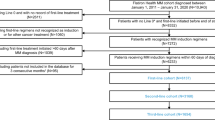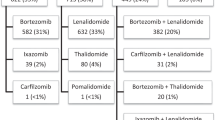Abstract
Early high-dose therapy (HDT), consisting of high-dose melphalan and autologous stem cell transplantation following doublet or triplet novel agent induction, is a preferred management strategy for transplant-eligible myeloma patients. We set out to examine the utility of the current fluorescence in situ hybridization (FISH)-based risk stratification in a homogenously treated population of transplant-eligible myeloma patients receiving novel induction regimens and early HDT with or without posttransplant maintenance therapy. FISH was available in 409 patients at the time of diagnosis for patients receiving HDT within 12 months of diagnosis. We present comprehensive outcomes for chromosome 14 translocations and 17p abnormalities that both support and refute current risk stratification models. In contrast to its current classification as a marker of 'standard risk' (SR), t(11;14) was associated with inferior overall survival (OS) when compared with the classical SR cohort. The use of novel agent maintenance therapy (bortezomib or lenalidomide) following early HDT ameliorates the negative prognostic value of high-risk (HR) cytogenetic markers. HR patients who received maintenance following early HDT had similar OS compared with the SR cohort at 5 years.
This is a preview of subscription content, access via your institution
Access options
Subscribe to this journal
Receive 12 print issues and online access
$259.00 per year
only $21.58 per issue
Buy this article
- Purchase on Springer Link
- Instant access to full article PDF
Prices may be subject to local taxes which are calculated during checkout




Similar content being viewed by others
References
Boccadoro M, Cavallo F, Gay FM, Di Raimondo F, Nagler A, Montefusco V et al. Melphalan/prednisone/lenalidomide (MPR) versus high-dose melphalan and autologous transplantation (MEL200) plus lenalidomide maintenance or no maintenance in newly diagnosed multiple myeloma (MM) patients. J Clin Oncol 2013; Suppl (ASCO abstracts): abstract 8509.
Palumbo A, Gay F, Spencer A, Di Raimondo F, Zdenek A, Larocca A et al. A phase III study of ASCT vs cyclophosphamide-lenalidomide-dexamethasone and lenalidomide-prednisone maintenance vs lenalidomide alone in newly diagnosed myeloma patients. Blood 2013; 122 (ASH abstracts): 763.
Moreau P, Attal M . All transplantation-eligible patients with myeloma should receive ASCT in first response. Hematology 2014; 2014: 250–254.
Rchardson PG, Laubach JP, Munshi NC, Anderson KC . Early or delayed transplantation for multiple myeloma in the era of novel therapy: does one size fit all? Hematology 2014; 2014: 255–261.
Chng WJ, Dispenzieri A, Chim C-S, Fonseca R, Goldschmidt H, Lentzsch S et al. IMWG consensus on risk stratification in multiple myeloma. Leukemia 2014; 28: 269–277.
Kapoor P, Fonseca R, Rajkumar SV, Sinha S, Gertz MA, Stewart AK et al. Evidence for cytogenetic and fluorescence in situ hybridization risk stratification of newly diagnosed multiple myeloma in the era of novel therapies. Mayo Clin Proc 2010; 85: 532–537.
Avet-Loiseau H. The future of FISH for the Diagnosis of Presenting Myeloma. EHA-SWG Scientific Meeting on Multiple Myeloma. September 2014. European Hematological Association: Barcelona, Spain, Abstract/Education book, pp 16–17.
Kumar S, Fonseca R, Ketterling RP, Dispenzieri A, Lacy MQ, Gertz MA et al. Trisomies in multiple myeloma: impact on survival in patients with high-risk cytogenetics. Blood 2012; 119: 2100–2105.
Avet-Loiseau H, Attal M, Moreau P, Charbonnel C, Garban F, Hulin C et al. Genetic abnormalities and survival in multiple myeloma: the experience of the Intergroupe Francophone du Myelome. Blood 2007; 109: 3489–3495.
Gertz MA, Lacy MQ, Dispenzieri A, Greipp PR, Litzow MR, Henderson KJ et al. Clinical implications of t(11;14)(q13;q32), t(4;14)(p16.3;q32), and -17p13 in myeloma patients treated with high-dose therapy. Blood 2005; 106: 2837–2840.
Chang H, Qi C, Yi QL, Reece D, Stewart AK . p53 gene deletion detected by fluorescence in situ hybridization is an adverse prognostic factor for patients with multiple myeloma following autologous stem cell transplantation. Blood 2005; 105: 358–360.
Drach J, Ackermann J, Fritz E, Krömer E, Schuster R, Gisslinger H et al. Presence of a p53 gene deletion in patients with multiple myeloma predicts for short survival after conventional-dose chemotherapy. Blood 1998; 92: 802–809.
Fonseca R, Blood E, Rue M, Harrington D, Oken MM, Kyle RA et al. Clinical and biologic implications of recurrent genomic aberrations in myeloma. Blood 2003; 101: 4569–4575.
Mikhael JR, Dingli D, Roy V, Reeder CB, Buadi FK, Hayman SR et al. Management of newly diagnosed symptomatic multiple myeloma: updated Mayo Stratification of Myeloma and Risk-Adapted Therapy (mSMART) Consensus Guidelines 2013. Mayo Clin Proc 2013; 88: 360–376.
Moreau P, Attal M, Garban F, Hulin C, Facon T, Marit G et al. Heterogeneity of t(4;14) in multiple myeloma. Long-term follow-up of 100 cases treated with tandem transplantation in IFM99 trials. Leukemia 2007; 21: 2020–2024.
Sasaki K, Lu G, Saliba RM, Bashir Q, Hosing C, Popat U et al. Impact of t(11;14)(q13;q32) on the outcome of autologous hematopoietic cell transplantation in multiple myeloma. Biol Blood Marrow Transplant 2013; 19: 1227–1232.
Durie BG, Harousseau JL, Miguel JS, Bladé J, Barlogie B, Anderson K et al. International uniform response criteria for multiple myeloma. Leukemia 2006; 20: 1467–1473.
Rajkumar SV . Multiple myeloma: 2014 update on diagnosis, risk-stratification, and management. Am J Hematol 2014; 89: 999–1009.
Soverini S, Cavo M, Cellini C, Terragna C, Zamagni E, Ruggeri D et al. Cyclin D1 overexpression is a favorable prognostic variable for newly diagnosed multiple myeloma patients treated with high-dose chemotherapy and single or double autologous transplantation. Blood 2003; 102: 1588–1594.
Attal M, Lauwers-Cances V, Marit G, Caillot D, Moreau P, Facon T et al. Lenalidomide maintenance after stem-cell transplantation for multiple myeloma. N Engl J Med 2012; 366: 1782–1791.
McCarthy PL, Owzar K, Hofmeister CC, Hurd DD, Hassoun H, Richardson PG et al. Lenalidomide after stem-cell transplantation for multiple myeloma. N Engl J Med 2012; 366: 1770–1781.
Palumbo A, Cavallo F, Gay F, Di Raimondo F, Ben Yehuda D, Petrucci MT et al. Autologous transplantation and maintenance therapy in multiple myeloma. N Engl J Med 2014; 271: 895–905.
Sonneveld P, Schmidt-Wolf IGH, van der Holt B, El Jarari L, Bertsch U, Salwender H et al. Bortezomib induction and maintenance treatment in patients with newly diagnosed multiple myeloma: results of the randomized phase III HOVON-65/ GMMG-HD4 trial. J Clin Oncol 2012; 30: 2946–2955.
Author information
Authors and Affiliations
Corresponding author
Ethics declarations
Competing interests
The authors declare no conflict of interest.
Additional information
Author contributions
GP Kaufman designed the research, collected and analyzed data and wrote the paper. SK Kumar designed the research, analyzed data and contributed to the writing of the paper. The other authors were involved in writing the manuscript.
Rights and permissions
About this article
Cite this article
Kaufman, G., Gertz, M., Dispenzieri, A. et al. Impact of cytogenetic classification on outcomes following early high-dose therapy in multiple myeloma. Leukemia 30, 633–639 (2016). https://doi.org/10.1038/leu.2015.287
Received:
Revised:
Accepted:
Published:
Issue Date:
DOI: https://doi.org/10.1038/leu.2015.287
This article is cited by
-
Multiple myeloma with t(11;14): impact of novel agents on outcome
Blood Cancer Journal (2023)
-
High-risk disease in newly diagnosed multiple myeloma: beyond the R-ISS and IMWG definitions
Blood Cancer Journal (2022)
-
Increasing genomic discovery in newly diagnosed multiple myeloma: defining disease biology and its correlation to risk
Annals of Hematology (2022)
-
Venetoclax in combination with carfilzomib and dexamethasone in relapsed/refractory multiple myeloma harboring t(11,14)(q13;q32): two case reports and a review of the literature
Journal of Medical Case Reports (2020)
-
Long-term survival and polyclonal immunoglobulin reconstitution after allogeneic stem cell transplantation in multiple myeloma
Annals of Hematology (2020)



